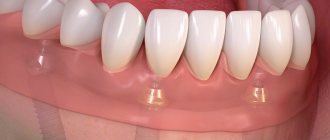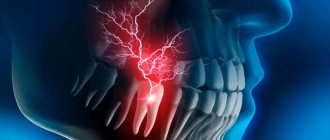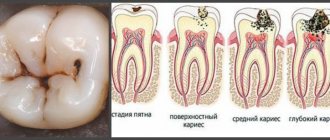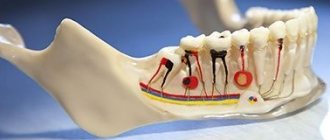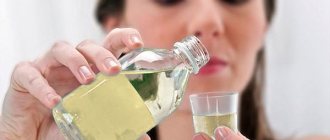17.11.2019
Many people mistakenly believe that a tooth is a completely bony structure. In fact, the dense shell is found only in the upper layers of the elements, and inside them there are nerve endings, represented by the pulp. Often, when the enamel is destroyed, the nerves also suffer, and in this case you have to urgently consult a doctor or try to reduce the unpleasant signs of the problem yourself. The causes of inflammation of the dental nerves and ways to combat the problem will be discussed in the article.
What is a dental nerve
To determine what a tooth nerve is, it is necessary to consider its entire structure. The upper or visible part of the elements is represented by dense enamel. It is characterized by increased strength and is designed to protect the lower layers from external influences and pathogenic flora. Dentin is the softer layer of the tooth, which makes up most of the elements. Under this layer is the pulp chamber, in the center of which there are nerve endings. These structures diverge along the root canals. Different teeth can have from 1 to 3 canals (depending on location and anatomical features).
When a tooth is deeply damaged, the nerve of the tooth hurts. The condition is accompanied by severe spasms that interfere with normal rest and leading a normal lifestyle.
You should not assume that the pulp is a useless tooth structure that should be immediately disposed of in case of carious lesions. It ensures the supply of valuable microelements to bone tissue. Nerve endings also signal that the tooth tissues are infected or injured. Pain makes it possible to take timely measures to preserve the integrity of the dentition.
After the pulp is removed, the supply of useful substances to the tooth tissues ceases. Over time, it loses its strength and becomes more vulnerable to carious processes. The risk of destruction of elements from familiar food products increases.
Several functions of nerves in teeth should be noted:
- Sensitive. Signals a person about the onset of pathological processes in dentin and pulp with pain.
- Nutritious.
- Immune.
Experienced dentists try to preserve the pulp as long as possible. It is especially important to preserve nerve endings in adolescents and children, since their dentition is not yet fully formed.
Many patients are interested in whether there are nerves in baby teeth. In structure, the elements in children are not much different from the indigenous ones. The only difference is thinner tooth enamel. For this reason, caries in children is often complicated by pulpitis, which requires the removal of nerve endings. In adults, the process of transforming caries into pulpitis takes from several months to 2-3 years; in children, complications develop within a few weeks (in rare cases, days).
Caries: how to relieve pain
Painful sensations from caries can take you by surprise, for example, at night. Without the opportunity to use the services of a dentist, you should help yourself. To ease the pain, it is recommended to take a pain reliever that you have already taken. In this case, you can protect yourself from unexpected intolerances and allergies. A cold compress on the sore spot or rinsing with a warm saline solution can alleviate the condition somewhat. It is not recommended to use any warming procedures for toothache, since in the case of inflammation or a purulent process, the situation can seriously worsen.
How long does a tooth hurt after filling a caries?
This is determined by the extent of the carious lesion before therapy and individual susceptibility. When treating an uncomplicated disease, aching, not pronounced pain can be felt for up to 5 days. Most often, the discomfort completely disappears on the 2-3rd day.
Causes of pain
Inflammatory diseases in the pulp chamber do not appear without reason. The pathological process develops as a result of certain factors:
- Caries or inflammatory diseases of the soft tissues of the mouth.
- Mechanical damage to the tooth or jaw bones, which exposes the nerve.
- Poorly performed dental treatment.
- Internal problems in the body of an infectious nature.
Signs of nerve inflammation always present with the same clinical picture, regardless of the cause of the problem. At the initial stages of the disease, a person notices an acute reaction of the teeth to temperature, chemical and taste stimuli.
As pulpitis progresses, other symptoms arise:
- bad breath associated with decay of tooth tissue;
- spasms of a pulsating nature, which are difficult to eliminate even with the help of powerful painkillers.
If not treated in a timely manner, pulpitis can develop into gumboil. In this case, there can be no question of saving the dental nerve. The main goal of flux treatment is to prevent further spread of infection in the body.
Why else can a nerve become inflamed? Factors that increase the risk of pulp damage include:
- poor quality or untimely oral care;
- unbalanced diet and predominance of soft foods in the diet;
- lack of preventive visits to the dentist.
Additionally
► What to do if a tooth pulsates when walking?
This kind of pulsation indicates the formation of denticles in the tooth cavity. Only a dentist can determine the cause after examination and carry out the necessary therapy.
► How to deal with tooth pulsation during pregnancy?
Uncontrolled use of medications to relieve pain during this period is undesirable, so as not to harm the child. Contact your dentist in a timely manner, without bringing your teeth to a state of complicated caries. If pain does occur, you can rinse your mouth with herbs before seeing a doctor.
Symptoms of the lesion
The main symptom of damage to the nerve endings in the tooth is pain. The patient will not be able to accurately indicate the location of the pain, since it is vague and can radiate to the ear, temple or eye. The symptom tends to increase with any jaw movements (during talking or eating). A sick tooth reacts very sharply to cold, hot or salty foods.
Another common sign of pathology is swelling of the cheeks and mucous membranes of the mouth. The symptom occurs due to inflammation of the pulp and compression of the nerve endings of the tooth. The intensity of pain usually changes when a person assumes different body positions. The attacks reach their maximum intensity at the moment when a person goes to bed. This is due to the fact that blood circulation in the affected area increases.
Why do you need to remove the affected tooth nerves? Without treatment, the infection can spread to the trigeminal nerve, resulting in pulpitis complicated by trigeminal neuralgia. The condition's symptoms are similar to a cold of the nerves.
It is easy to distinguish neuralgia from pulpitis: the pain is unilateral and manifests itself as involuntary muscle twitching. In more complex cases, a nervous tic may occur. The consequence is manifested by impaired facial expressions, one-sided distortion of the face
How long does a tooth hurt after deep caries treatment?
In this case, therapy is much more complicated. The doctor has to perform more traumatic manipulations:
- open the tooth cavity with a drill;
- remove pulp;
- clean the affected areas with needle files;
- expand the lumen;
- measure the depth of the working area;
- perform antiseptic treatment;
- fill the voids that form in the canal with filling material;
- install a seal.
As a result, tooth tissue takes up to 3 weeks to heal.
If the pain persists longer than the specified period, becomes more intense, and is accompanied by headaches, fever, and inflammation of the gums, then it is necessary to urgently seek dental help. Any delay and hope that it will go away on its own can lead to serious complications that will require several months to be treated.
Ways to deal with pain at home
There are several ways to independently remove pain associated with inflammation of nerve endings. The main goal of home methods is to reduce the sensitivity of the rotted nerve.
- Alcohol. It cannot completely kill the nerve, but it can reduce the activity of pathogenic flora in the carious cavity. It works well as a mouth rinse and reduces the intensity of pain for a while.
- Powder. A small amount of a substance is placed into the affected area, which effectively relieves pain. It is important not to overdo the dosage of gunpowder, since intoxication of the body is possible. We do not recommend using this method, as it is very dangerous.
- Vinegar. The product is pre-mixed with water in a 1:1 ratio, since pure vinegar causes burns to the mucous membranes of the mouth. A cotton swab is moistened in the solution and applied to the carious cavity for 15 minutes.
- Pepper. Preference is given to spices with peas. The product is crushed and placed on the diseased tooth.
For arsenic to work, it must be placed in previously cleaned dental canals. If even a small dose of the substance enters the intestines, it will be fatal.
All of the above measures are emergency. Even in the absence of re-exacerbation of signs of pulpitis, you should consult a doctor. An infection inside a tooth cannot be destroyed on its own.
To relieve pain, you can use not only folk remedies, but also pharmaceutical preparations intended for dental procedures.
The following solutions are suitable for self-depulpation:
- Cresofen. The main active ingredient of the product is dexamezone. The drug is available in the form of drops and has a gentle effect on the mucous membranes of the mouth. The product is used only after pre-treatment of the carious cavity with antiseptics at home. To improve the therapeutic effect, Crezofen is recommended to be used in combination with antibiotics. After using the drug, rinse the mouth with plenty of water.
- Kaustinev Rapid. Consists of 1/3 arsenic solution. The remaining components in the product are considered auxiliary. The duration and frequency of use of the drug depends on how deep the exposed dental nerve is located. If the pulp is located close to the carious cavity, then it is possible to relieve pain symptoms with one application of the solution.
- Davis ARS. Arsenic is also an active component of the drug. The advantage of the medication is the quick and effective elimination of toothaches. The effect of using the product is observed after 1-2 days. The drug is available in the form of syringes or liquid with a universal dosage.
- Devin - P. The drug is available in the form of a paste, which includes analgesic and antiseptic substances: menthol, chlorophenol, camphor oil. This drug is used to relieve the symptoms of pulpitis if medications with arsenic are prohibited for use. Due to the absence of arsenic in the composition, the paste is approved for dental treatment even for children.
Not always products with arsenic can calm the dental nerve at home. This is due to several reasons:
- the impossibility of penetration of the substance into the dental canals due to their location being too deep;
- increased blood circulation in the affected tooth caused by exposure to the substance;
- pain in the treated area due to intoxication with the substance;
- individual intolerance to arsenic;
- The temporary filling is too dense.
Instead of peroxide-based drugs, you can use pharmaceuticaldehydes. Hydrogen peroxide and iodine help relieve acute toothache for a while.
What complications can there be from home methods?
Even a doctor during depulpation can make a mistake that will lead to undesirable consequences. What can we say about independent attempts to kill the pulp at home, without following any rules of asepsis and antiseptics. Among the possible negative consequences of such arrogance, experts note nerve separation, severe hemorrhage due to vascular injury, as well as the spread of inflammation to nearby tissues. Other possible problems include:
- allergic reaction to the substances used,
- injury to healthy tissues,
- burn of the mucous membrane,
- loss of taste sensitivity,
- infection and sepsis.
When using home methods, a burn may occur.
Most often, after trying to kill the pulp on their own using traditional methods, patients are faced with a severe burn of the mucous membrane. In other cases, the pulp is burned with preservation but serious damage to the nerve.
Nerve removal in a clinical setting
The procedure for nerve removal in the clinic is carried out under anesthesia, regardless of the scope of work.
Sequence of actions for depulpation:
- The dentist isolates the surgical area from the surrounding tissues using a waterproof film - a rubber dam.
- The specialist removes dead areas of dentin and enamel by filing, using air cooling technology.
- Opening the pulp chamber and extracting nerve endings from it.
- Rinsing the dental canals with antiseptics to prevent further infection of the tooth and soft tissues.
- Root canal filling.
- Carrying out a control x-ray.
- Placement of a temporary filling.
The dentist may offer the patient complete or partial depulpation. In the first case, the procedure lasts up to 2 hours, depending on the complexity of the work and the size of the carious cavity. The doctor installs temporary material into the treated tooth, which kills the remnants of nerve endings. After 2-3 days, the patient will need to visit the doctor again to install permanent material.
Partial depulpation involves a one-step solution to the problem. After it, the tooth retains the same sensitivity and ability to resist pathogenic flora.
During partial depulpation, the dentist uses several types of instruments:
- Drop-shaped drill. Necessary to increase the lumen of the dental canals.
- Riemer. It is a metal wire with a pointed end. Used to expand straight sections.
- Pulpoextractor. Allows you to remove inflamed nerves from the tooth.
- Miller needle. Allows dentists to view canals.
During the procedure, specialists may encounter a number of problems that interfere with partial depulpation:
- curvature of channels;
- maintaining tooth sensitivity even after anesthesia;
- chipping of the crown of a tooth.


